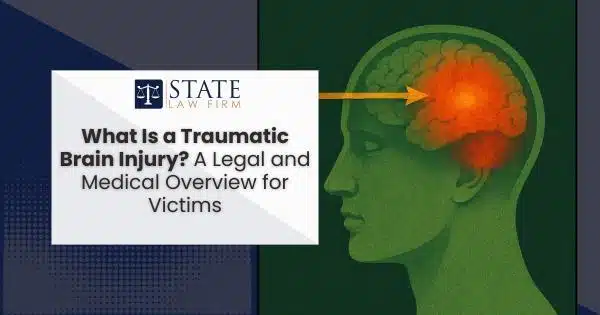A traumatic brain injury (TBI) can change everything in an instant, but no two TBIs affect victims in the same way. From mild concussions that heal in weeks to severe head trauma that causes lifelong disability, the spectrum of injuries is broad, and so are the medical and legal challenges families face along the way.
Each year, an estimated 2.8 million Americans sustain a TBI (CDC), most commonly due to falls, car accidents, and sports impacts. For many, recovery involves more than just physical healing — it means navigating insurance claims, documenting hidden symptoms, and ensuring fair compensation for future care and treatment.
At State Law Firm, our young team of evolving litigators understands how the severity of your brain injury can shape your legal options and your path to recovery. In this guide, we break down what victims and families need to know about:
- The medical definitions and categories of TBIs — from closed head injuries to penetrating trauma
- The most common causes and risk factors
- Recognizing subtle symptoms that often go overlooked
- Modern treatment options and rehabilitation resources
- The legal steps to protect your rights and secure fair compensation
- Finding trustworthy support systems during recovery
If your brain injury stems from a vehicle collision, our Sherman Oaks car accident lawyers are ready to fight for your best possible outcome. And if you’re facing lingering complications, explore our insights on the long-term effects of traumatic brain injuries to better plan for the road ahead.
We’re here to guide you through the legal maze — and help you focus on what truly matters: healing and moving forward.
Understanding Traumatic Brain Injury (TBI): Definition and Types
A traumatic brain injury happens when a sudden bump, blow, or jolt disrupts the brain’s normal function. Medical professionals categorize TBIs broadly as closed or open (penetrating) head injuries:
- Closed Head Injury: The skull remains intact, but internal damage occurs from the brain moving within the skull. Concussions are the mildest form, while diffuse axonal injuries are severe and life-threatening.
- Open Head Injury: An object penetrates the skull and brain tissue, causing localized damage that may require emergency surgery.
Severity also ranges from mild (short loss of consciousness or confusion) to severe (extended coma, permanent impairment). Even a “mild” TBI can have severe long-term impacts if not diagnosed and treated correctly
Pro Tip: Always seek medical care after a blow to the head — symptoms can develop hours or days after the injury.
The Causes and Risk Factors Associated with Traumatic Brain Injuries
Understanding how traumatic brain injuries (TBIs) occur can help prevent them and build a strong case if negligence is involved. Common causes include:
- Falls are the leading cause, especially among young children and older adults.
- Vehicle Accidents: A Major Contributor for Teens and Adults — Our Sherman Oaks car accident team handles these cases daily.
- Sports Injuries: Concussions from football, soccer, or cycling are frequent in youth athletes.
- Assaults: Less common but often severe.
Risk factors like age, prior head injuries, and certain occupations (construction, sports) can increase vulnerability.
Pro Tip: Document the incident thoroughly — including photos, witness information, and medical reports — as this strengthens your legal claim.
Identifying the Symptoms and Diagnosis of Traumatic Brain Injury
Symptoms vary widely depending on severity and the part of the brain affected. Be alert for:
- Mild TBI: Headache, confusion, dizziness, sensitivity to light or noise, brief loss of consciousness.
- Moderate to Severe TBI: Prolonged unconsciousness, slurred speech, repeated vomiting, seizures, or profound behavioral changes.
Doctors use neurological exams and imaging tests (CT scans, MRIs) to diagnose the injury. Subtle injuries may require follow-up scans to detect delayed swelling or bleeding.
Pro Tip: Keep a journal of symptoms and changes — this can be robust evidence if your condition worsens.
The Medical Treatment Options Available for Traumatic Brain Injury Victims
Treatment depends on the nature and severity of the TBI:
- Mild TBI: Rest, over-the-counter pain management, and gradual return to daily activities.
- Moderate to Severe TBI: Hospital care, possible surgery to relieve pressure, and close monitoring for complications.
Long-term recovery often includes:
- Physical therapy for mobility and strength.
- Occupational therapy for everyday tasks.
- Speech and cognitive therapy for memory and communication challenges.
- Medications for mood swings, headaches, or sleep disturbances.
Rehabilitation can be extensive and costly — your legal team can help secure compensation to cover these necessary expenses.
Navigating the Legal Aspects: What Victims Need to Know About Their Rights
When someone else’s carelessness causes a TBI, victims have the right to pursue compensation for:
- Medical expenses, both current and future
- Lost wages and diminished earning capacity
- Pain and suffering
- Long-term care and rehabilitation costs
Working with an experienced personal injury lawyer makes a difference, especially when proving the hidden impacts of a brain injury. Our attorneys understand how to present complex medical evidence and fight for your full recovery.
Pro Tip: The sooner you involve a lawyer, the stronger your claim will be. Early evidence collection and expert support are key.
The Importance of Support Systems and Resources for Survivors and Families
A traumatic brain injury affects more than just the injured person — it touches every family member. Building a strong support system can make recovery more manageable and less isolating. Consider:
- Local TBI Support Groups: Connecting with Others Who Understand the Journey.
- Counseling services are available for both survivors and caregivers.
- Community and nonprofit organizations: Many offer free educational materials, resource guides, and care planning advice.
Don’t underestimate the value of compassionate support and a trusted legal team fighting for your future. For more insight into what recovery may look like, explore our guide on the long-term effects of traumatic brain injuries.
Final Thoughts
A brain injury can upend your life in countless ways, but you do not have to face the medical, emotional, and legal challenges alone. At State Law Firm, our driven team is here to stand with you, guide you through the legal process, and help you secure the compensation and peace of mind you deserve.


